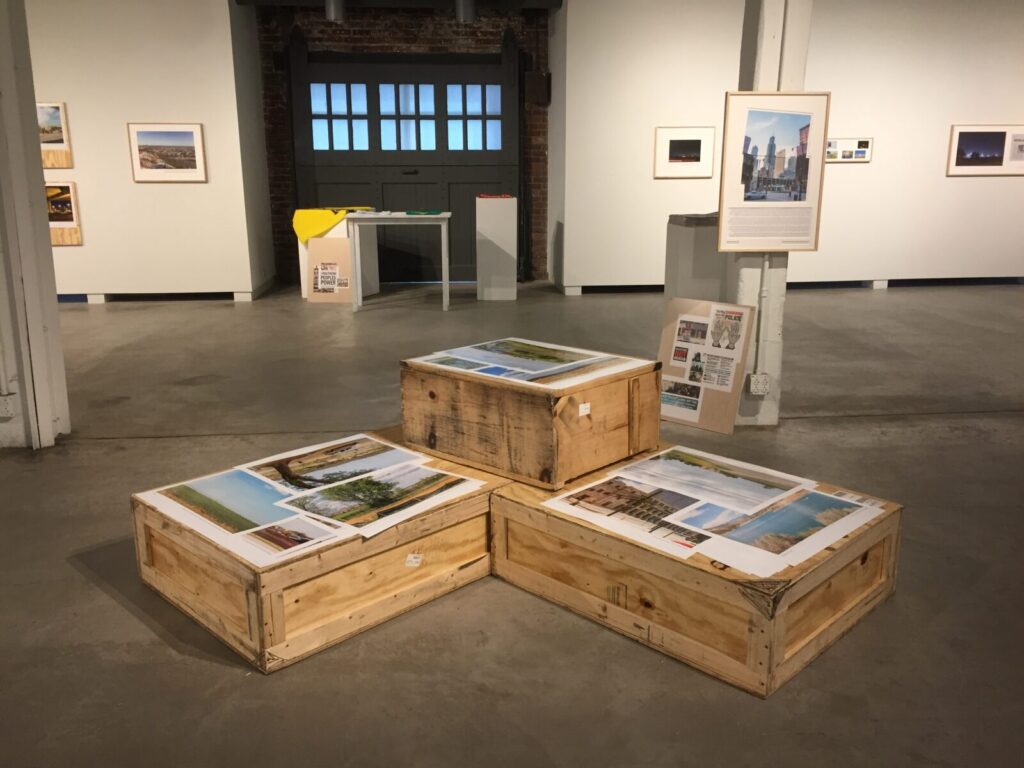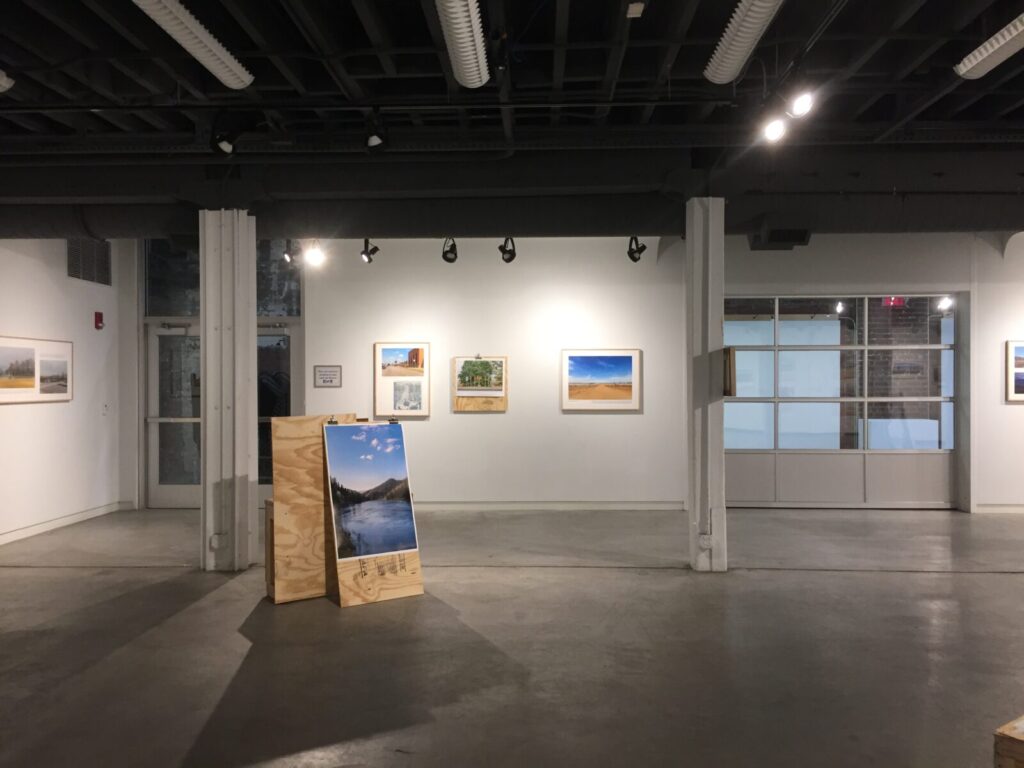To consider the prison today is to consider matters of deep political urgency, but few institutions are more obscure. More than 2 million people currently live in American prisons, and over twice that are in “the system” (awaiting trial, in jail, on parole, etc.). These numbers have skyrocketed since the 1970s, but as this has happened, the prisons themselves have moved out of sight to the hinterlands of the late capitalist landscape. They now occupy the edges of cities alongside factories and office parks, and they offer salvation to rural communities in the throes of economic decline.
Ashley Hunt’s exhibition Degrees of Visibility at the University of Kentucky’s Bolivar Gallery surveys this new landscape of confinement. The main focus of the show is a recent series of photographs depicting jails, detention centers, and prisons in every U.S. state and territory. These images are accompanied by a series of text pieces and found objects that address the prison system in conceptual and activist terms. The back room of the gallery showcases his documentary film series, Corrections, made in the years between 2001 and 2008.
The photographs are often most revealing when the prisons are concealed. Hunt photographed them from public places and, as a result, the images sometimes offer only the scantest glimpses of guard towers, concertina wire, or even less than that. His image of a federal prison in Oakdale, Louisiana, for example, features little more than the stretch of earth between chain-link and picket fences. Likewise, in his image of Blackburn Correctional Complex in the northern part of Lexington, houses and condominiums bookend a length of fence and a cluster of trees just beyond a sprawling but unremarkable expanse of suburban lawn. Such images speak to the ordinariness of incarceration; prisons are now, in the words of Georges Bataille, objects of our “daily inattention.”
Many of these images feature captions with backstories and contexts. In one instance, we learn that San Rafael in Marin County, California, buried its jail in a massive tumulus and covered it with vegetation to preserve the bucolic splendor of a Civic Center designed by Frank Lloyd Wright. In several captions, these bits of context offer ironic rejoinders to an optimism that still clings to the American landscape.
We read that Taylor, Texas was settled by immigrants from Eastern Europe, but now hosts a detention center to imprison migrant women prior to their deportation. And we read that California’s Colonel Allensworth State Park commemorates an African-American farming community and experiment in self-governance, but now the site is surrounded by nearly 20 prisons, jails, and detention facilities.
 Many of these landscapes suggest antecedents from the history of photography. Upon seeing these images, I can barely resist comparing them to works by Joel Sternfeld, Robert Adams, and even Thomas Struth, but the exhibition’s installation often undercuts this impulse to aestheticize. Many of the photographs are unframed; Hunt clamps some of them to pieces of plywood, and he stacks others on top of wooden shipping crates. These loose leaf pieces feature quadrille-ruled borders, and often this minimalist-cum-bureaucratic device suggests an analytic rather than aesthetic context for these images even as it seems to extend the prisons’ chain link fencing all the way to the edges of the paper. A few of the framed photographs hang like signposts on the slender columns that break up the space, and they echo all the road signs reading “prison area” or “no trespassing” in photographs that surround them.
Many of these landscapes suggest antecedents from the history of photography. Upon seeing these images, I can barely resist comparing them to works by Joel Sternfeld, Robert Adams, and even Thomas Struth, but the exhibition’s installation often undercuts this impulse to aestheticize. Many of the photographs are unframed; Hunt clamps some of them to pieces of plywood, and he stacks others on top of wooden shipping crates. These loose leaf pieces feature quadrille-ruled borders, and often this minimalist-cum-bureaucratic device suggests an analytic rather than aesthetic context for these images even as it seems to extend the prisons’ chain link fencing all the way to the edges of the paper. A few of the framed photographs hang like signposts on the slender columns that break up the space, and they echo all the road signs reading “prison area” or “no trespassing” in photographs that surround them.
 In addition to the photographs, Hunt includes works that document and describe the history of the prison system in the United States. A small diagram, for example, chronicles the growth of the American population in prison over 165 years, beginning with 1 in every 3,442 people in 1850 and concluding with 1 in 132 in 2014. Tellingly, those numbers spiked dramatically in the wake of the Civil War and after the Civil Rights movements.
In addition to the photographs, Hunt includes works that document and describe the history of the prison system in the United States. A small diagram, for example, chronicles the growth of the American population in prison over 165 years, beginning with 1 in every 3,442 people in 1850 and concluding with 1 in 132 in 2014. Tellingly, those numbers spiked dramatically in the wake of the Civil War and after the Civil Rights movements.
Another panel offers context for these vastly increased incarceration rates: “Replacing chattel slavery with penal slavery,” it reads, “the 13th Amendment to the U.S. Constitution moved slavery out of its explicitly racial discourse and into the sanitized discourse of criminality and crime control.” Later the text describes the contemporary prison as “an institution of counter-insurgency against internally colonized, jobless, displaced, and rebelling populations.”
Among the show’s most significant inclusions are a series of displays that shift our attention from documenting the prison system to activist efforts against the social and political forces that sustain it. Placards foreground the activism of the California-based prison abolitionist group Critical Resistance, for example, or the Atlanta-based groups Project South and Southerners on New Ground, dedicated to LGBTQ rights. Tables and pedestals display T-shirts opposing mountaintop removal mining or migrant prisons.
These installations, especially the pedestals, have a distinctly museal character compared to other works in the exhibition, but they do the vital work of connecting opposition to mass incarceration to other activist causes. Bundles of newsprint piled onto the floor of the gallery and stacked on top of wooden crates feature conversations with activists that flesh out these connections. In one conversation, Hunt talks to members of Critical Resistance, and in another, he speaks with Kentucky-based activists Judah Schept and Debraun Thomas.
These conversations elaborate on the many intersections between the inequities of contemporary society and the rise of the contemporary prison system. Through these aspects of the show, Hunt demonstrates that mass incarceration is implicated in almost every other social and political problem today, from racism to drug abuse to economic inequality; it represents one of most insidious consequences of an endemic social violence.
In all these ways, Hunt’s exhibition goes far beyond a prevalent model of documentary photography—a kind of fascination photography—which catalogs recurrent features of our landscape and mise–en-scène. This mode enjoins us to revel in commonalities and variations, whether they occur in architecture or commodities or the natural world. In Hunt’s work, this archive of images becomes part of a political economy of incarceration, and it pushes past fascination and towards a critical engagement with both prisons and the forces that sustain them. His work offers an indispensable guide not only to the prison industrial complex, but to a society that treats so many of its inhabitants as the expendable—and often invisible—refuse of a punitive social order.






